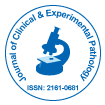当社グループは 3,000 以上の世界的なカンファレンスシリーズ 米国、ヨーロッパ、世界中で毎年イベントが開催されます。 1,000 のより科学的な学会からの支援を受けたアジア および 700 以上の オープン アクセスを発行ジャーナルには 50,000 人以上の著名人が掲載されており、科学者が編集委員として名高い
。オープンアクセスジャーナルはより多くの読者と引用を獲得
700 ジャーナル と 15,000,000 人の読者 各ジャーナルは 25,000 人以上の読者を獲得
インデックス付き
- 索引コペルニクス
- Google スカラー
- シェルパ・ロミオ
- Jゲートを開く
- Genamics JournalSeek
- ジャーナル目次
- ウルリッヒの定期刊行物ディレクトリ
- レフシーク
- ハムダード大学
- エブスコ アリゾナ州
- OCLC-WorldCat
- パブロン
- ジュネーブ医学教育研究財団
- ユーロパブ
- ICMJE
役立つリンク
オープンアクセスジャーナル
このページをシェアする
抽象的な
Carbaryl, A Pesticide Causes “Reproductive Toxicity” in Albino Rats
Sajad Hamid, Seema Sharm and Shayama Razdan
The key to man’s health lies largely in his environment & often man is responsible for the pollution of his environment through urbanization, industrialization and other human activities for example commercial agriculture and garden pest control etc. by using pesticides. Pesticides, though present in the environment in small quantities as compared to other contaminants such as industrial wastes and fertilizers, account for public and scientific concern due to their high biological activity. In the recent years, use of carbamate insecticides has gained importance due to ban of the insecticides belonging to Organochlorine groups that is D.D.T., Aldrin, Lindane and Endosulfan. These pesticides have a tendency to persist and have potential to bioaccumulate in the body Kamrin [1]. Concern about the susceptibility of the male reproductive system to drugs or environmental agents has assumed an increasing extent. The outcome of such exposures have included not only reduced fertility but also embryo/fetal loss, birth defects, childhood cancer, and other postnatal or functional deficits. Carbaryl is one of the most important insecticides as it is widely produced and used which has prompted us to initiate this study . The present study was conducted on 40 male Wistar albino rats as experimental animals. The rats were procured from the Animals House of the Department of Pharmacology, Government Medical College, Jammu. The rats were divided in four groups as normal control group I, group II, group III and group IV. All the rats were group housed and were fed with standard pellet diet and water for two weeks. After two weeks, the rats of group I were left as such and rats of groups II, III and IV were given 50 mg, 100 mg and 200 mg/kg body weight/day of carbaryl drug in 0.2 ml of groundnut oil orally, 6 days/week for 60 days, respectively. After 60 days, all the rats were anaesthetized by keeping them in an inverted glass jar containing large piece of cotton soaked in anaesthetic ether. The testis were dissected out from each rat and were cut into smaller pieces. These pieces were immediately fixed in 10% formalin. The blocks were prepared for section cutting with a microtome by paraffin wax embedding method. The sections of 7 μ thickness were mounted on glass slides and were stained by H&E and Masson’s trichome stain. The following findings are drawn from the study:- (1) There is variation in the shape of seminiferous tubules of testis. (2) There is sloughing of the germinal cells from the basement membrane. (3) There is depressed spermatogenesis and loss of sperms. (4) Some tubules are showing accumulation of cellular masses in the lumen of seminiferous tubules of testis. (5) Interstitial spaces are showing the oedema. (6) Degenerated Leydig cells are also seen. These findings are highly conclusive of reproductive toxicity produced by an insecticide, Carbaryl. It is concluded that the toxic effects are more pronounced in the peripheral parts of the sections of testis. Moreover, intensity of toxic effects both in peripheral and central parts increases with increase in dosage of the carbaryl drug.

 English
English  Spanish
Spanish  Chinese
Chinese  Russian
Russian  German
German  French
French  Portuguese
Portuguese  Hindi
Hindi